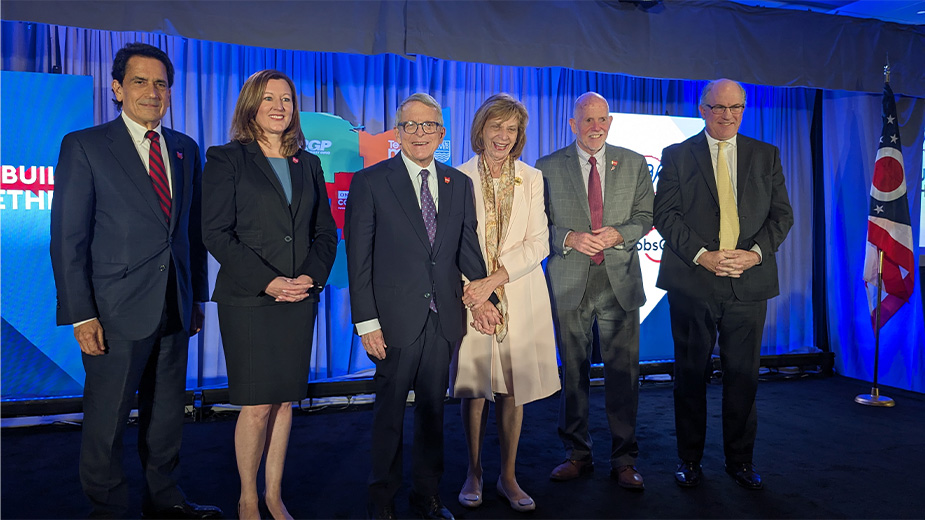Action Group Hears How Downtown Compares to Peers
YOUNGSTOWN, Ohio – Even though Youngstown’s downtown placed in the lower end of an analysis of peer communities, the retired Youngstown State University professor who conducted the analysis says he’s encouraged about what the results mean.
Dr. Tom Maraffa, who retired last year from YSU’s geography department, presented the results of the analysis at Tuesday’s meeting of the Downtown Youngstown Economic Action Group.
Maraffa identified 14 peer cities based on primary criteria of location within the Northeast, Great Lakes or Midwest; a city population of less than 300,000; and metropolitan area population of less than 800,000. Secondary criteria included having a university near the city’s central business district and access to a river or waterfront.
“Peer cities are like benchmarks, and when you select peer cities, you have a couple of goals,” he said. One is that they be comparable to the city being studied. The other is they should be “somewhat aspirational. They should be places that you want to strive for,” Maraffa remarked.
Based on 2012 data for all the peer cities, Youngtown’s downtown ranked near the bottom in comparison with the peer communities in most categories, including terms of employment, payroll and number of business establishments in the central business district.
“I would look at this as a cause for optimism, myself, because when you look at the experiences of these cities, these tell us what’s possible in the Youngstown downtown,” Maraffa said. Peer cities included Toledo; Flint, Mich.; Scranton and Reading in Pennsylvania; Utica, N.Y.; and South Bend, Ind.
“One of the reason these cities are where they are compared to Youngstown is they have been engaged in a process a lot longer than Youngstown,” he continued. “Youngstown is just getting started in terms of a coherent effort to develop the downtown and the city. So it’s natural that it would be behind in a lot of these measures.”
The four ingredients to a successful downtown are employment base, activities that attract people from within the region, such as banking or other personal business; activities that attract people from beyond the region, such as attending events at the Covelli Centre or going to a museum; and a residential base.
“One of the things that’s happening to the downtown in many cities is it’s become another neighborhood, with its own character and attracting its own demographics,” Maraffa said. “That’s something that didn’t exist 30 years ago.”
The city ranked last in terms of percentage of metro area payroll concentrated in the central business district, with the downtown accounting for less than 2% of the metro area’s payroll. That means economic activities are “much less concentrated” in Youngstown’s downtown than its peer cities, he said.
“What that means is that economically Youngstown’s downtown is less important to the overall economy of the metropolitan area than the downtowns of the peer cities,” Maraffa remarked.
The downtown did better in rankings of payroll per employee, placing seventh. The average payroll per employee is just below $40,000 annually. “That’s a good sign. That means that the jobs that are in the downtown area are reasonably high-paying jobs,” he said.
“It’s always helpful to see how we measure up to similar sized cities that have gone through similar experiences,” said Dominic C. Marchionda, facilitator for the economic action group.
“The important thing is a consistent effort in the same direction over a long period of time,” Maraffa said. “When we do higher education planning, we think in terms of decades. You can’t really accomplish anything in less than a decade of any significance. One of the reasons Ohio State has been so successful is they have had the same vision and same plan for 20 years.”
The key to how Youngtown’s peer cities have progressed is they’ve identified their vision and committed to it, Marchionda said.
“Of course, plans change and opportunities arise but they all came together across sectors, collaborated and committed to that vision until projects were implemented and progress was made,” he continued. “That’s something that’s still to be seen, how far we get and if we can go down that route.”
Recognizing that civic and community leadership changes over time, one of the economic action group’s goals is to serve as a support mechanism and a monthly platform, bringing in speakers and providing leadership with the facts and tools to address the challenges of getting funding to make improvements.
Following the meeting, Marchionda said the city and his group are in the early stages of addressing the downtown parking situation. Downtown parking was among the factors cited by the owner of Roberto’s Italian Ristorante in his recent decision to discontinue serving lunch.
“The parking situation, it’s a little bit chopped up and antiquated in terms of legislation and parking on street versus off street management,” he said. That policy probably hasn’t been updated for a few decades, he remarked. “We need to go through all the parking resolutions and figure out what’s the best comprehensive way to update them not only on that quadrant of downtown but throughout the university and downtown area, coming up with best plan for users of downtown.”
The upcoming wayfinding signage is part of the effort, he said. The signage will help direct visitors to downtown not only to their destinations but also to the best parking based on what they need to do and how long they will be staying in the downtown area.
RELATED: From Tuesday’s New York Times
Youngstown,Ohio Reinvents Its Downtown
Copyright 2024 The Business Journal, Youngstown, Ohio.



